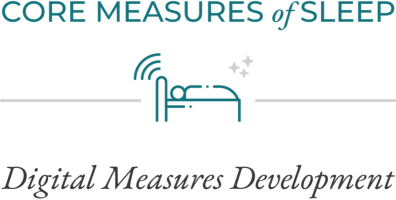Join us to transform mental health research and care
Get involved in an upcoming DiMe project

Use these resources to objectively measure and assess sleep across various conditions – reducing the implementation time for sleep measurement while increasing transparency and consistency.

Use the resources below to implement the core set of digital measures of sleep in practice and to support you throughout the process.
As you work to select and procure digital solutions, use this technical document to learn more about core digital parameters at the algorithm output level.
Sleep digital measurement products are now included in this library, making it a valuable, one-stop-shop for you to access high-quality digital clinical measures, measurement tools, and datasets to use in your research and care.
Use these graphics, illustrating the connection of core measures with interpretation, in your work. They are designed in various styles and link to our core measures with recommendations from the National Sleep Foundation’s published consensus work.
Different technologies can estimate sleep staging using data collected from different sensor-based sources (e.g., EEG, actigraphy, ballistocardiography, etc.). Each technology type has different properties that impact the estimation of sleep staging. Understanding the technology used to collect the data and its strengths and limitations is important for later interpretation of, and confidence in, the
arising results.
The estimations of sleep staging are at the heart of the Core Digital Measures of Sleep. The Core Measures: Sleep Measurement System provides three levels of sleep staging, from coarse grain awake vs asleep, to fine grain N1-N3 and REM staging. The needs will vary based on the context of use and research question employed, so it is important to know the resolution of sleep stage estimation.
Different technologies interpret sleep staging and other sleep events at different time intervals called epochs. Polysomnography uses 30-second epochs, but digital health technologies (DHTs) may have a different resolution. Although a fine resolution can be more sensitive, increased sensitivity isn’t necessary for all purposes. It is important to know what epoch length the selected DHT uses, as it informs the interpretation of the results and comparability to other existing research.
When following the Core Measures: Sleep Measurement System, it is important to be able to detail the certainty in the data. For example, if an individual is recorded as asleep for a single 30 second epoch, is this length of time enough to be confident that they were asleep? Instead, several epochs estimating sleep may be more appropriate before determining that the individual has reliably achieved sleep. Asking the vendor what rules they have in place for all relevant variables is an important step for future interpretation of results.
Some DHT providers offer epoch level data. Others provide summary data. Summary data may already be labelled in line with the core measures (such as “wake after sleep onset” or “total sleep time”). To align with the Core Digital Measures of Sleep, epoch level data is preferrable. This data can be used alongside the Core Measures: Sleep Measurement System to both define the Core Digital Measures of Sleep, and other measures that may be pertinent to the research question and study under development.
While being provided with summary data is not an issue, there are limitations to the further analysis that can be conducted with summary data. For example, it limits comparison between two measurement systems. In addition, it is important to understand how the summary data is created and the similarity to the definitions laid out in the Core Digital Measures of Sleep. If a provider offers summary data it is important to ask them for descriptions of the estimation process to derive the summary data and assess whether this is in line with the Core Digital Measures of Sleep.
Some technologies estimate sleep continuously. Others estimate sleep during defined “rest periods”. Depending on the study needs can be an important consideration (for example detecting typical sleep versus narcoleptic episodes)
Sleep staging algorithms are often proprietary by nature. This is not an issue, but evidence for the validity and reliability of the estimated sleep stages is important to have confidence in the results arising from the use of the technology. A vendor should be able to provide evidence, which could include peer reviewed manuscripts. However, a wealth of information can be found in the technical documentation the vendor provides. Where conference abstracts exist, they may be able to share further information for inclusion into, for example, regulatory documents.